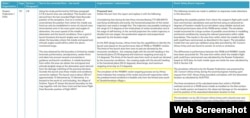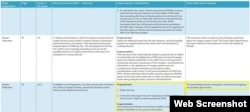Dutch investigators repeatedly rebuffed Russian efforts to insert alternative theories into an authoritative report about the July 2014 downing of a Malaysia Airlines passenger plane over eastern Ukraine, according to documents released along with the anxiously awaited report on October 13.
Appendices published (here and here) with the Dutch Safety Board’s report show that Russia attempted to convince investigators to invoke "other scenarios," such as the possibility that Flight MH17 was struck by an air-to-air missile.
Critics have accused Moscow of floating the air-to-air-missile and other theories in order to deflect attention from substantial evidence indicating the Boeing 777 was downed by a Russian-made surface-to-air missile system known as a Buk, fired from an area controlled by pro-Russian separatists in eastern Ukraine.
But the documents released with the report show that, behind the scenes, the Dutch Safety Board also rejected alternative scenarios proposed by Russia as essentially baseless before concluding that a Buk missile exploded next to the Boeing 777 and sent it crashing to the ground, killing all 298 people on board.
With arcane discussions of physics, telemetry, and military technology, the conclusions of the 15-month investigation largely match up with theories put forth by Ukraine, the United States, and other nations.
Here is a snapshot of some of the back-and-forth between Russia and the Dutch investigators, who appear to have met with Russian officials and technicians on several occasions to gather evidence and hear arguments.
It Was An Air-To-Air Missile
On July 21, just days after the crash, the Russian Defense Ministry claimed that that a Ukrainian Air Force Su-25 fighter jet had been tailing MH17 and may have shot it down. Russia's Investigative Committee has claimed that a Ukrainian soldier gave evidence suggesting MH17 was shot down by an air-to-air missile. An October 2014 documentary broadcast by the Russia's state-owned TV channel, RT, which was formerly known as Russia Today, further publicized that theory.
Here, Russia complains that the air-to-air missile theory "is practically not presented" in the report. Dutch investigators, however, says the issue is "adequately addressed" and that they are “not aware of any evidence that suggests that other weapon systems both capable of causing the crash and containing the distinct pre-formed fragments were present in the region."
It Was A Ukrainian Missile
Dutch investigators combined data from MH17's flight data recorder along with the projected flight path of the missile with details such as how shrapnel entered the Boeing. They concluded that it was fired from a 320-square-kilometer area not far from the village of Snizhne. At the time, the area was reportedly largely under the control of separatist fighters.
The manufacturer of the Buk missile system, a Russian state-owned company called Almaz-Antey, said it ran its own calculations that looked at the angle at which the missile would have approached the aircraft before detonating. The company said that indicates it was launched from near the village of Zaroshchenske, some 30 kilometers west of Snizhne. Pro-Russian separatists have said the region was then controlled by Ukrainian forces.
Here, the Dutch report dismisses the Russian evidence, saying that would have resulted in a "damage pattern that did not match the observed damage on the [airplane] or the associated detonation location."
The Dutch Safety Board notes here, and elsewhere in the report, that its mandate was relatively narrow and that things like culpability for those who actually pulled the trigger on the missile would be left to a separate criminal investigation.
It Could Have Been Many 'Other Scenarios'
Dutch investigators say they cast their net widely in considering all possibilities -- the quality of the MH17 flight crew, the state of the Boeing 777, the nature of the shrapnel holes, among many other things. But they also state clearly in the report that they looked at other theories and then ruled them out.
"Other possible scenarios that could have led to the disintegration and crash of the [airplane] were considered, analyzed, and excluded," they wrote.
Russian officials, however, sought to reword that specific sentence to read: "There exist other scenarios that could lead to in-flight break-up of the aircraft" -- an assertion that would dilute the definitive tone of the report.
The Dutch report rejected that suggestion outright: "The comment is not adopted as it is correct to state that the other scenarios are all excluded."
It Wasn’t Russian Armed Forces
Since violence erupted in eastern Ukraine in April 2014, starting in the regional commercial center of Donetsk then spreading north, east, and south, Russia has steadfastly maintained that rebel groups are made up of locals along with "volunteers" from Russia, who join the fighting in Ukraine on their own volition, without authorization or government backing.
Those assertions have been consistently undermined by the presence of sophisticated weaponry such as the Buk missile system, heavy artillery used with highly professional efficiency, and even Russians who have been captured by Ukrainians and have openly stated the units they are serving with.
Additionally, reporters and open-source bloggers have located military graves in Russia that indicated the soldiers buried there died while serving in Ukraine.
An earlier version of the Dutch report apparently sought to explain the participants in the conflict, including the Russian armed forces in that list.
Russia bluntly told investigators to remove that mention of Russian armed forces, saying "the Russian Federation is not a party of this conflict."
The Dutch report appears to have ultimately ceded to this demand, removing the passage that offended Moscow. The final report also appears to have changed the terminology to the more ambiguous description: "armed groups fighting the Ukrainian government."



















